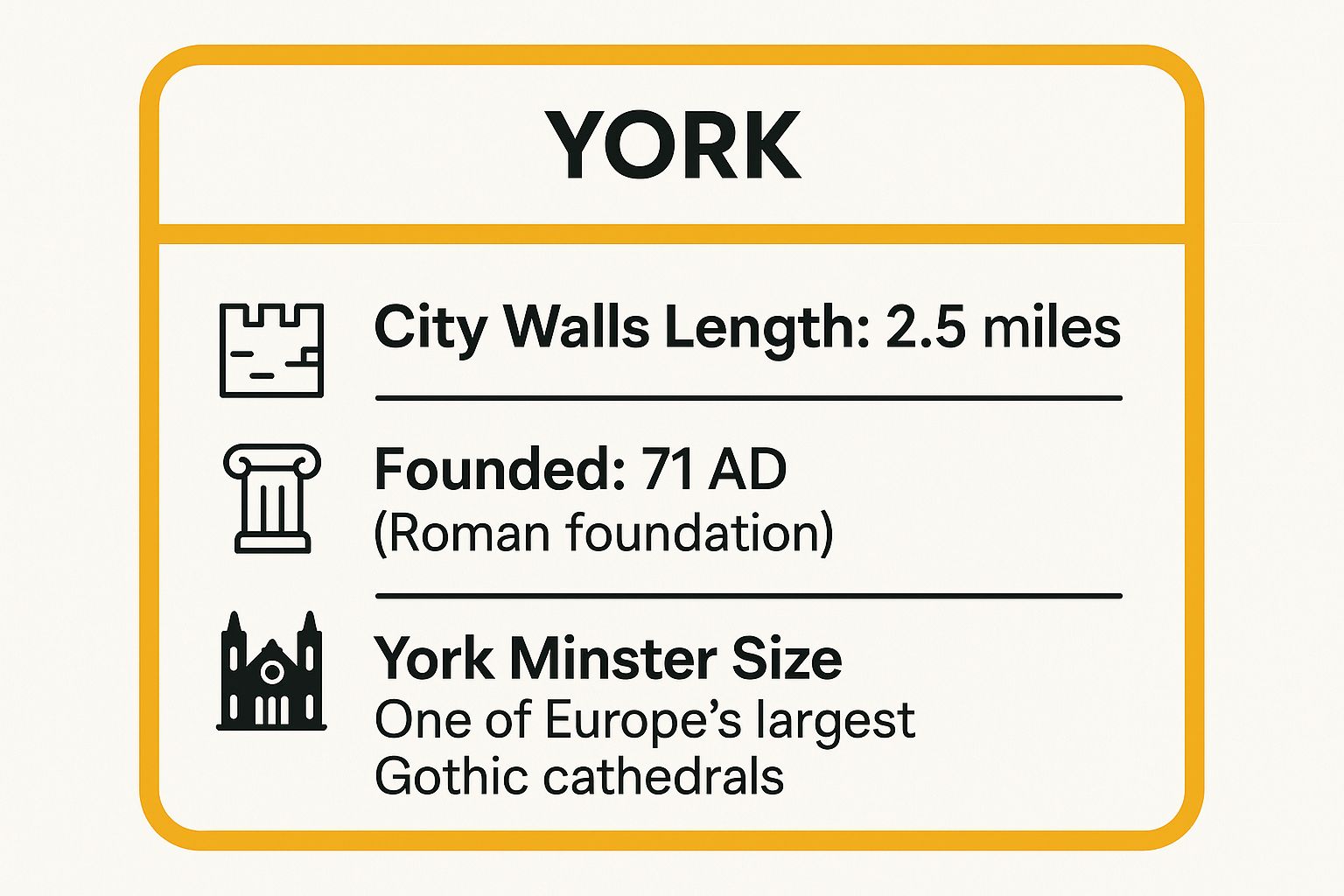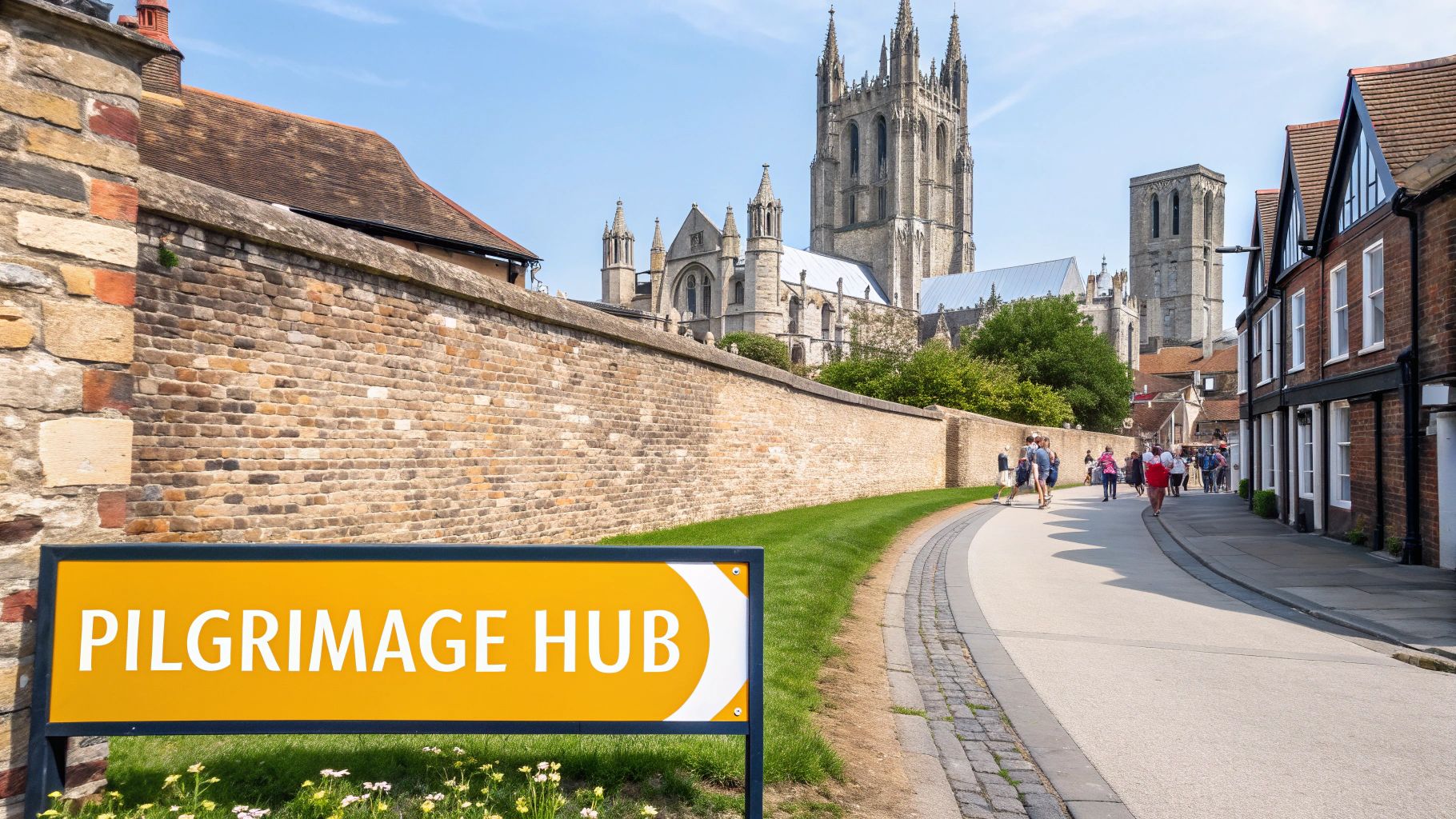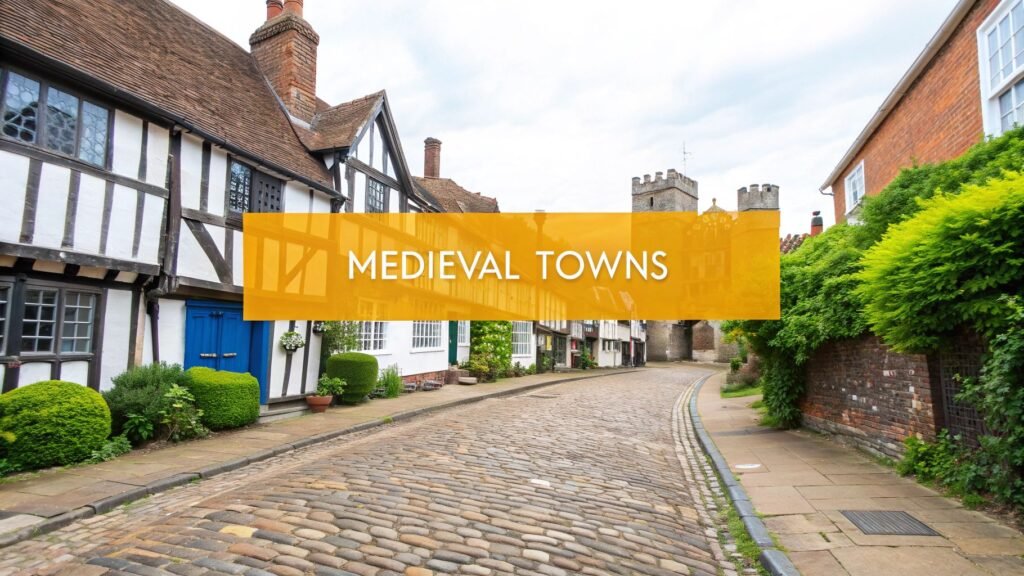England’s story is etched in stone, timber, and winding cobbled streets. Beyond the bustling modern cities lies a landscape dotted with settlements where the medieval world feels tantalisingly close. These are not mere ruins but living communities where centuries of history echo with every footstep. From the formidable fortress towns that once guarded the Welsh Marches to the hallowed pilgrimage sites that drew the faithful from across Europe, each location offers a unique window into a dramatic and formative era of English history.
This guide is your key to unlocking the secrets of the most captivating medieval towns in England. We have curated a list of must-visit destinations, moving beyond the obvious to provide practical, actionable advice for the independent traveller. For each town, you will find not just a summary of its historical highlights but also insider tips for exploring, specific driving directions for easy access, and hand-picked accommodation suggestions to complete your journey.
Our focus is to provide a comprehensive resource that helps you plan a truly immersive trip. Forget generic overviews; this article delivers the details you need to navigate ancient city walls, discover unique two-tiered shopping galleries, and understand the stories that shaped a nation. Prepare to trade the motorway for the market square and discover the enduring magic of a proper medieval town England experience.
1. York
York offers an unparalleled journey into England’s past, standing as one of the nation’s most complete medieval cities. Founded by the Romans as Eboracum, it later became the Viking capital of Jorvik before flourishing as a powerful medieval trading and ecclesiastical centre. This rich history is not just confined to museums; it is etched into the very fabric of the city, from its winding alleyways to its towering cathedral, making it an essential destination for anyone seeking an authentic medieval town in England.
Historical Highlights and What to See
The city is a living museum, where ancient structures still serve the modern population. At its heart is the magnificent York Minster, one of the largest and most impressive Gothic cathedrals in Europe. Nearby, the Shambles, a narrow, cobbled street with overhanging timber-framed houses, provides a vivid impression of medieval urban life and is believed to be the inspiration for Diagon Alley in the Harry Potter series.
For a comprehensive view of York’s medieval importance, visit the Merchant Adventurers’ Hall, a stunningly preserved timber-framed guildhall. A walk along the city’s 2.5 miles of medieval walls offers breathtaking panoramic views and a unique perspective on the city’s layout.
To understand York’s heritage at a glance, the following summary highlights some of its most impressive statistics.

These figures underscore the scale and enduring legacy of York’s historical foundations, from its extensive defensive walls to its monumental cathedral.
Insider Travel Tips
To make the most of your visit, timing is key. Explore the Shambles early in the morning or later in the afternoon to avoid the largest crowds and capture the best photographs. For a truly atmospheric experience, attend the evensong service at York Minster; the choral music echoing through the vast space is unforgettable. Guided walking tours are highly recommended to uncover the hidden histories and stories that bring the city to life. Its excellent rail connections also make it a perfect stop; you can explore UK rail journeys that include York for a scenic and convenient travel option.
2. Canterbury
Canterbury holds a profound and unique place in England’s history, defined by its role as the epicentre of English Christianity and a premier medieval pilgrimage destination. Following the dramatic martyrdom of Archbishop Thomas Becket in 1170, the city was transformed into one of Europe’s most significant religious sites, a journey immortalised in Geoffrey Chaucer’s The Canterbury Tales. This legacy shaped the city’s very layout, with its magnificent cathedral at its heart, surrounded by a network of streets, inns, and churches built to welcome countless pilgrims, making it an essential medieval town in England.

Historical Highlights and What to See
The city’s spiritual and architectural centrepiece is the awe-inspiring Canterbury Cathedral, a masterpiece of Gothic design and a UNESCO World Heritage Site. Inside, you can see the site of Becket’s murder and admire the stunning collection of medieval stained-glass windows. For an immersive experience, The Canterbury Tales attraction recreates the sights, sounds, and smells of Chaucer’s medieval England.
Beyond the main attractions, you can walk along sections of the ancient city walls and pass through the impressive Westgate Towers, England’s largest surviving medieval gateway. History extends even further back at St Martin’s Church, the oldest parish church in continuous use in the English-speaking world. The cathedral grounds also house The King’s School, one of the oldest schools in the world.
Insider Travel Tips
To fully appreciate the cathedral’s splendour, book tickets and tours in advance, especially during peak season, to secure your spot. For a truly authentic experience, consider attending an evensong service to hear the choir’s magnificent voices fill the historic space. To connect with the city’s pilgrim past, you can walk a portion of the Pilgrims’ Way, a historic route that leads into Canterbury. Also, explore the tranquil ruins of St Augustine’s Abbey, another key part of the city’s World Heritage Site, which offers a quieter but equally fascinating glimpse into its monastic history.
3. Chester
Chester offers a distinctive medieval experience, where centuries of history are layered upon Roman foundations. Its most celebrated feature, The Rows, is a unique system of two-tiered covered galleries lining the main streets, an architectural marvel unparalleled in medieval Europe. This innovative design not only maximised commercial space but also provided shoppers with shelter, cementing Chester’s status as a prosperous and sophisticated medieval town in England.

Historical Highlights and What to See
Chester’s history unfolds as you explore its streets and structures. The most prominent feature, The Rows, allows you to shop and wander along historic walkways that have been in continuous use for centuries. Nearby, Chester Cathedral boasts some of the finest medieval choir stalls in the country, featuring intricate carvings that offer a glimpse into the medieval imagination.
A walk along the complete circuit of the city walls, the most complete in Britain, is essential. The route passes the iconic Eastgate Clock and provides views of the Roman Amphitheatre, vividly illustrating the city’s Roman and medieval heritage existing side-by-side. Many former medieval guildhalls are still in use, having been adapted into modern shops and restaurants, allowing visitors to dine and shop within buildings that have stood for over 700 years.
Insider Travel Tips
To fully appreciate Chester’s unique layout, walk the full circuit of the city walls first; it provides a fantastic overview and helps you orient yourself. When exploring The Rows, be sure to visit both the street-level shops and the upper galleries, as they offer completely different perspectives and experiences. For a relaxing view of the city’s medieval bridges and defensive towers from a different angle, consider a river cruise on the Dee. If your visit aligns, experiencing the Chester Mystery Plays, a tradition dating back to the 14th century, offers an authentic taste of medieval drama and community life.
4. Warwick
Warwick exemplifies the classic medieval castle town, where urban development was intrinsically linked to one of England’s most magnificent medieval fortresses. The town grew under the protection and patronage of the powerful Earls of Warwick, flourishing as a prosperous market hub while retaining its crucial military significance. This symbiotic relationship between castle and town created a unique urban environment that balanced defence, commerce, and daily life, making Warwick a quintessential medieval town in England.
Historical Highlights and What to See
The town’s identity is dominated by the formidable Warwick Castle, an immense stone fortress whose Great Hall and State Rooms offer an immersive glimpse into noble life. Beyond the castle walls, the Lord Leycester Hospital provides a rare look into medieval guild life with its stunning timber-framed courtyard and historic almshouses, which have been in continuous use for over 400 years.
A short walk leads to the Collegiate Church of St. Mary, home to the exquisite Beauchamp Chapel, which contains some of England’s finest medieval tomb sculptures. For a sense of the town’s original layout, visitors can see remnants of the medieval defensive system and cross the ancient Mill Bridge, a structure that has served the town for centuries. The town’s medieval market charter is still active, with bustling markets held in the historic Market Place.
Insider Travel Tips
To fully appreciate Warwick Castle, dedicate a full day to its exploration, including the dungeons and grounds. For a more intimate experience, visit the Lord Leycester Hospital and take a tour with one of the resident “Brethren” for personal anecdotes and historical insights. Attend one of the castle’s many medieval-themed events, such as jousting tournaments or archery displays, to see history brought to life. A climb to the top of St. Mary’s church tower is also highly recommended for panoramic views of the town and its historic relationship with the castle.
5. Shrewsbury
Shrewsbury’s unique charm as a medieval town in England comes from its dramatic setting, almost entirely encircled by a loop of the River Severn. This natural moat provided formidable defences, shaping its destiny as a powerful and prosperous medieval border settlement between England and Wales. Its wealth, built on the wool trade, is reflected in an extraordinary architectural legacy, with over 660 listed buildings, many of which are distinctive black-and-white timber-framed structures that define its historic core.
Historical Highlights and What to See
The town’s layout is a maze of medieval shuts and passages, best explored on foot. Dominating the skyline is Shrewsbury Castle, a red sandstone fortress originally built by the Normans to control the Welsh border. Nearby, St. Mary’s Church boasts a magnificent collection of medieval stained glass, some of the finest in the country.
A walk through the town centre reveals architectural treasures at every turn. Visit The Bear Steps, a picturesque medieval courtyard linking Fish Street and Milk Street, and admire the timber framing of the Old Market Hall. Crossing the river via the English Bridge, a successor to the original medieval crossing, provides stunning views back towards the town’s historic skyline.
Insider Travel Tips
To fully appreciate Shrewsbury’s hilly terrain and cobbled streets, comfortable footwear is essential. Taking a guided walking tour is highly recommended to delve into the town’s fascinating history as a bulwark against Welsh incursions. For a deeper look at its past, visit the Shrewsbury Museum & Art Gallery to see medieval artefacts unearthed locally. Plan your visit to coincide with a market day to experience the vibrant atmosphere in the historic market square. For a perfect photo opportunity, follow the riverside path for the best panoramic views of the town. As it’s perfectly positioned to explore both England and Wales, you can discover tours of the region for a comprehensive travel experience.
6. Ludlow
Ludlow represents the pinnacle of medieval planned town development, a settlement carefully designed to support the massive hilltop castle controlling the Welsh Marches. Its grid-pattern streets and central market square demonstrate sophisticated medieval urban planning, a stark contrast to the organic, winding lanes of older towns. This strategic design, coupled with its role as the seat of the Council of Wales, made it the effective capital of Wales during the late medieval and Tudor periods, cementing its status as a key historic medieval town in England.
Historical Highlights and What to See
The town’s history is dominated by its magnificent fortress, Ludlow Castle, where you can explore the Great Hall and the rare circular Norman chapel. The castle’s history is intertwined with the very fabric of English monarchy, serving as a royal palace and administrative hub for centuries. In the town itself, St. Laurence’s Church, often called the “Cathedral of the Marches,” showcases exceptional medieval architecture, including a remarkable set of carved misericords.
For a taste of medieval hospitality, the iconic black-and-white timber-framed facade of The Feathers Hotel provides a stunning example of Jacobean architecture built upon medieval foundations. The town’s layout remains remarkably preserved, with many streets still bearing their original medieval names, offering a direct link to the artisans and traders who once lived and worked there.
Insider Travel Tips
To fully appreciate the town’s strategic layout, combine a visit to the castle with a walk through the town’s grid system. For a unique experience, plan your trip around the Ludlow Food Festival, held in the medieval market square, which transforms the town centre into a bustling hub reminiscent of its historic past. A walk along the old town walls and the riverside paths offers fantastic views and a deeper understanding of Ludlow’s defensive system. Don’t just stay within the walls; the surrounding Shropshire countryside provides a beautiful context for the medieval landscape this town once commanded.
7. Conwy
Conwy offers a rare glimpse into a complete medieval fortified town, a masterpiece of 13th-century military architecture. Built by Edward I during his conquest of Wales, the town and its colossal castle are a UNESCO World Heritage site. Its remarkably preserved circuit of town walls, punctuated by 21 towers, encloses the original medieval street plan, creating an authentic atmosphere that transports visitors straight back to the High Middle Ages. This integration of a powerful fortress with a planned settlement makes Conwy an exceptional example of a medieval town in Britain.
Historical Highlights and What to See
The town’s formidable defences are its greatest draw. Dominating the skyline is the magnificent Conwy Castle, with its eight massive towers offering commanding views over the estuary and mountains. Visitors can walk the complete 1.3km circuit of the medieval town walls, an experience that provides unparalleled perspectives of the castle and the historic town nestled below. This walk is one of the most complete of its kind in Europe.
Within the walls, explore the narrow streets leading to the historic quayside, where you can find the Smallest House in Great Britain. Another must-see is Plas Mawr, an incredibly well-preserved Elizabethan townhouse, showcasing intricate plasterwork and period furnishings. This blend of military might and domestic history makes Conwy a uniquely compelling medieval destination.
Insider Travel Tips
To get the best value and experience, purchase a joint ticket from Cadw (the Welsh historic environment service) which grants access to both Conwy Castle and the town walls. The wall walk is best enjoyed early in the morning before the main crowds arrive, offering peaceful, golden-hour views. Allow for a full day to properly explore the castle, walls, and the historic town itself without rushing. Conwy serves as a fantastic base for exploring the other great fortresses of North Wales, and you can discover more about touring this historic region of Wales to plan a broader journey through its medieval past.
8. Richmond, Yorkshire
Richmond offers a powerful glimpse into the immediate aftermath of the Norman Conquest, with a town deliberately planned around one of England’s earliest and best-preserved stone castles. Perched dramatically above the River Swale, the town grew from a formidable military stronghold into a bustling commercial centre. The combination of early Norman military architecture with a grand, planned marketplace makes Richmond an exceptional example of a post-conquest medieval town in England, demonstrating how power and commerce were intrinsically linked.
Historical Highlights and What to See
The town’s layout and key structures speak volumes about its medieval origins. Dominating the skyline is Richmond Castle, its massive 11th-century keep offering a visceral sense of Norman power and providing stunning views over the town and Yorkshire Dales. Below the castle lies the vast cobbled Market Place, one of the largest in England, which still hosts vibrant weekly markets that echo its medieval past.
Uniquely, the marketplace is also home to the Holy Trinity Church, which once served as a place of worship and a commercial hub. For a different cultural perspective, the nearby Georgian Theatre Royal is a beautifully preserved 18th-century playhouse, while the Green Howards Museum delves into the area’s rich military heritage, tracing its lineage back to local militias.
Insider Travel Tips
To experience the town at its most vibrant, visit on a Saturday to see the historic marketplace in full swing. For the best views, climb the keep of Richmond Castle; the panoramic vista of the Yorkshire Dales is truly spectacular. Take a scenic riverside walk starting from the medieval bridge at the bottom of the town to appreciate the castle’s imposing position from a different angle. Richmond serves as a perfect gateway to the Yorkshire Dales, so consider combining your visit with an exploration of the national park for a complete historical and natural escape.
Medieval Towns of England: Key Features Comparison
| City | Implementation Complexity | Resource Requirements | Expected Outcomes | Ideal Use Cases | Key Advantages |
|---|---|---|---|---|---|
| York | High – Preserving extensive ancient structures | Significant funding for maintenance and archaeology | Authentic medieval urban experience, major tourist hub | Historical tourism, education, archaeology | Exceptional preservation, rich multi-period heritage, living city |
| Canterbury | Moderate – Balancing religious heritage and modern needs | Ongoing restoration and tourist management | Spiritual pilgrimage site, literary tourism | Religious studies, pilgrimage tourism, cultural education | UNESCO status, international religious significance, literary fame |
| Chester | High – Maintaining unique timber structures and Rows | Specialized craftsmen, conservation funding | Unique medieval commercial architecture, vibrant tourism | Architectural study, heritage shopping experience | Only two-level medieval shopping galleries, strong local economy |
| Warwick | Moderate – Focus on castle and surrounding town preservation | Funding for castle upkeep and medieval buildings | Military heritage tourism, medieval urban study | Military history, medieval reenactments, market town visits | Well-preserved fortress, balanced defense and commerce |
| Shrewsbury | Moderate – Managing narrow streets and flood risks | Infrastructure adaptation for accessibility | Border history exploration, timber-frame architecture | Historical tours, Welsh border studies, architecture | Distinctive timber buildings, dramatic topography, literary connections |
| Ludlow | Moderate – Preserving planned medieval town layout | Conservation of heritage buildings and castle | Planned town exploration, cultural festivals | Medieval urban planning education, food and cultural tourism | Outstanding planned town, strong cultural events, manageable size |
| Conwy | High – Maintaining complete walled town and castle | Extensive fortification upkeep, tourism management | Comprehensive medieval military urban experience | Military architecture study, heritage tourism | Most complete medieval walled town in Britain, UNESCO status |
| Richmond, Yorkshire | Moderate – Preservation of early Norman structures | Maintenance of castle and marketplace infrastructure | Early Norman history, rural medieval experience | Norman conquest studies, rural heritage tourism | Earliest stone castle, largest cobbled marketplace in England |
Planning Your Own Medieval Adventure
Our journey through England’s medieval past, from the Viking-haunted streets of York to the formidable castle walls of Warwick, reveals a landscape rich with stories. We’ve explored the unique half-timbered “Rows” of Chester, walked the sacred paths of pilgrims in Canterbury, and delved into the borderland history of Shrewsbury and Ludlow. Each destination offers a distinct window into a formative era of English history, a time of castles, cathedrals, and conflict that shaped the nation.
The true beauty of exploring any medieval town in England is discovering how these historical narratives are woven into the fabric of modern life. It’s not just about viewing ancient structures; it’s about experiencing the enduring spirit of these places. Whether you’re marvelling at the sheer scale of Conwy Castle or enjoying a quiet moment in a Richmond pub that has served patrons for centuries, you are connecting with a living heritage.
Weaving Your Historical Tapestry
The key takeaway is that your adventure doesn’t have to follow a rigid script. The real magic lies in the freedom to linger, explore, and create your own itinerary. By understanding the unique character of each town, you can tailor a journey that speaks directly to your interests.
- For the Military History Buff: A route connecting Warwick, Conwy, and Richmond offers an unparalleled look at defensive architecture and strategic border control.
- For the Architectural Enthusiast: Combining Chester, Shrewsbury, and York provides a masterclass in the evolution of building styles, from Roman foundations to Tudor timber-framing.
- For the Culinary Traveller: A journey centred on Ludlow, renowned for its food culture, can be expanded to include the historic market towns of Shrewsbury and Richmond, discovering local produce and centuries-old recipes.
This list is merely a starting point. The true value lies in using this knowledge to craft a personal and immersive experience. By planning a self-drive tour, you give yourself the ultimate flexibility to chase your curiosity, whether that leads you down a hidden medieval alleyway in York or to a scenic viewpoint overlooking the River Severn in Shrewsbury. You become the architect of your own historical exploration, creating a journey that is as unique as the towns themselves.
Ultimately, visiting a medieval town in England is about more than sightseeing. It is an opportunity to step away from the present and gain a tangible connection to the past. It’s about walking in the footsteps of kings, knights, merchants, and monks, and realising that their stories are still etched into the very stones beneath your feet. This journey offers a profound sense of perspective, reminding us of the resilience, ingenuity, and enduring legacy of those who came before us.
Ready to turn inspiration into an unforgettable journey? The expert team at BTOURS specialises in crafting bespoke self-drive itineraries that bring the history of medieval England to life. We handle all the planning, from authentic accommodation to optimised routes, so you can focus on the adventure. Start designing your personalised medieval tour with BTOURS today.



